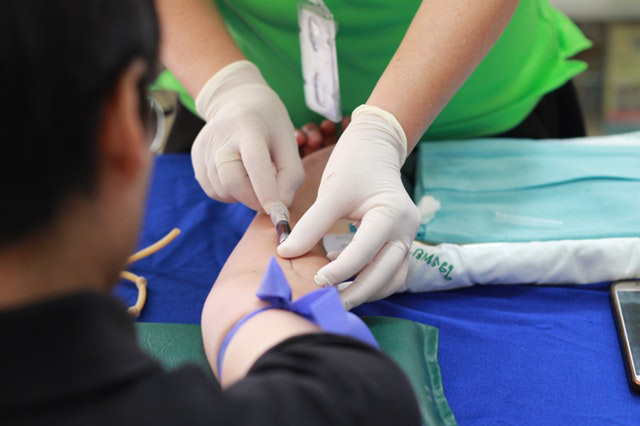Northeast Medical Institute - New Haven Campus Phlebotomy Course & Cna Class Things To Know Before You Get This
Northeast Medical Institute - New Haven Campus Phlebotomy Course & Cna Class Things To Know Before You Get This
Blog Article
Not known Details About Northeast Medical Institute - New Haven Campus Phlebotomy Course & Cna Class
Table of ContentsNortheast Medical Institute - New Haven Campus Phlebotomy Course & Cna Class Can Be Fun For EveryoneRumored Buzz on Northeast Medical Institute - New Haven Campus Phlebotomy Course & Cna ClassNortheast Medical Institute - New Haven Campus Phlebotomy Course & Cna Class for DummiesHow Northeast Medical Institute - New Haven Campus Phlebotomy Course & Cna Class can Save You Time, Stress, and Money.Unknown Facts About Northeast Medical Institute - New Haven Campus Phlebotomy Course & Cna ClassNot known Details About Northeast Medical Institute - New Haven Campus Phlebotomy Course & Cna Class
The use of such devices need to be accompanied by other infection prevention and control techniques, and training in their usage. Not all safety devices apply to phlebotomy. Prior to choosing a safety-engineered tool, users should thoroughly explore readily available gadgets to determine their ideal usage, compatibility with existing phlebotomy methods, and efficiency in shielding team and individuals (12, 33).For setups with low sources, expense is a motoring factor in purchase of safety-engineered gadgets - CNA Courses. Where safety-engineered tools are not readily available, proficient use a needle and syringe is appropriate. Unintended exposure and details info concerning an incident need to be taped in a register. Assistance services need to be advertised for those that undergo unexpected exposure.
In the blood-sampling room for an outpatient division or facility, give a comfortable reclining sofa with an arm rest.
Fascination About Northeast Medical Institute - New Haven Campus Phlebotomy Course & Cna Class
Ensure that the indications for blood sampling are plainly specified, either in a created procedure or in recorded instructions (e.g. in a lab kind). Whatsoever times, comply with the approaches for infection prevention and control provided in Table 2.2. Infection avoidance and control methods. Collect all the equipment needed for the procedure and place it within safe and simple reach on a tray or cart, making certain that all the products are clearly visible.
Where the client is adult and aware, follow the actions laid out listed below. Introduce yourself to the individual, and ask the client to mention their full name. Check that the research laboratory form matches the client's identification (i.e. match the individual's information with the research laboratory form, to make sure accurate identification). Ask whether the license has allergies, phobias or has actually ever before collapsed during previous shots or blood attracts.
Make the individual comfy in a supine position (if possible). Location a clean paper or towel under the client's arm. Discuss the test to be performed (see Annex F) and get verbal consent. The patient has a right to reject a test at any moment before the blood tasting, so it is very important to ensure that the individual has comprehended the procedure.
9 Simple Techniques For Northeast Medical Institute - New Haven Campus Phlebotomy Course & Cna Class
Expand the person's arm and inspect the antecubital fossa or lower arm. Locate a blood vessel of an excellent dimension that is noticeable, straight and clear.
DO NOT place the needle where capillaries are diverting, because this increases the chance of a haematoma. Locating the blood vessel will certainly aid in establishing the proper size of needle.
Haemolysis, contamination and presence of intravenous liquid and medication can all alter the results (39. Nursing personnel and physicians might access main venous lines for specimens following methods. However, samplings from central lines carry a risk of contamination or wrong laboratory examination results (https://disqus.com/by/disqus_LRlCsjutUE/about/). It serves, yet not perfect, to injure specimens when very first presenting an in-dwelling venous tool, before attaching the cannula to the intravenous fluids.
5 Simple Techniques For Northeast Medical Institute - New Haven Campus Phlebotomy Course & Cna Class
Allow the area to dry. Failure to permit adequate contact time raises the risk of contamination. DO NOT touch the cleaned website; specifically, DO NOT place a finger over the vein to direct the shaft of the exposed needle. It the site is touched, repeat the sanitation. Execute venepuncture as adheres to.
Ask the patient to form a fist so the blood vessels are more famous. Go into the capillary promptly at a 30 degree angle or much less, and remain to introduce the needle along the vein at the easiest angle of access - CNA Courses. As soon as enough blood has actually been collected, launch the tourniquet prior to withdrawing the needle
The 10-Minute Rule for Northeast Medical Institute - New Haven Campus Phlebotomy Course & Cna Class
Withdraw the needle delicately and apply gentle stress to the site with a clean gauze or dry cotton-wool sphere. Ask the client to hold the gauze or cotton wool in position, with the arm expanded and elevated. Ask the patient NOT to flex home the arm, due to the fact that doing so triggers a haematoma.

The Ultimate Guide To Northeast Medical Institute - New Haven Campus Phlebotomy Course & Cna Class
Do not push the syringe bettor due to the fact that additional stress boosts the threat of haemolysis. Where feasible, maintain the tubes in a shelf and move the rack towards you. Infuse downwards right into the ideal coloured stopper. DO NOT remove the stopper because it will release the vacuum cleaner. If the example tube does not have a rubber stopper, inject exceptionally slowly right into television as lessening the stress and speed used to transfer the sampling minimizes the danger of haemolysis.

Report this page